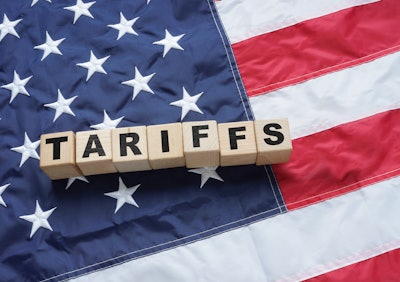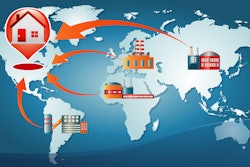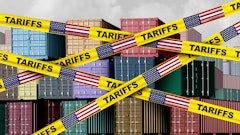
The unpredictability of U.S. tariff policies has increased uncertainty for global businesses, according to the findings of the 2025 Allianz Trade Global Survey. The results reveal a stark shift in expectations for growth, perceptions of risks, especially with regards to payment delays, and diverse strategies to mitigate the effect of the trade war. Even with the advent of bilateral trade deals in recent weeks, the fog of uncertainty isn’t breaking.
“In sharp contrast to the optimism seen before the April 2 tariff wave, this year’s global survey confirms what we’re observing across markets: uncertainty and fragmentation are becoming structural. ‘Liberation Day’ exposed the vulnerabilities of companies with highly concentrated supply chains and export markets. The numbers speak for themselves: global positive export expectations dropped from 80% to 40%, and 42% of companies now expect export turnover to fall between -2% and -10%, compared to just 5% before the April 2 announcements. Despite recent bilateral agreements with the UK and China, we estimate global export losses will reach $305 billion in 2025. Companies are not standing still. Having navigated successive shocks since 2020, they are once again adapting, diversifying partners, reconfiguring logistics, and embedding risk-sharing across the value chain. In today’s trade environment, success depends increasingly on adaptability,” says Aylin Somersan Coqui, CEO of Allianz Trade.
Key takeaways:
· The Allianz Trade Global Survey reveals that close to 60% of firms expect a negative impact from the trade war, and 45% expect export turnover to decline. The impact goes beyond trade volumes: more than one in four firms are considering temporary production halts due to the combination of tariffs and currency volatility, particularly in sectors reliant on imported intermediate goods. In the United States, 26% of firms said they plan to stop imports or offshore production to avoid delays and rising costs.
· After the April 2 “Liberation Day” tariff announcements, 54% of U.S. companies said they plan to raise prices, the highest among surveyed countries, signaling limited margin flexibility. Only 41% of U.S. firms plan to increase investments in 2025, down 6 percentage points from before the announcements. Payment challenges are mounting as well: 73% of U.S. firms report receiving export payments between 30-70 days, and 36% expect payment terms to lengthen by over 7 days.
· Notably, 62% of U.S. exporters anticipate an increase in non-payment risk, up 21 percentage points after “Liberation Day.” While some relief has arrived via the U.S.-China deal reducing average bilateral tariffs to 39%, this remains far above pre-war levels (13%), suggesting continued reliance on friendshoring and alternative sourcing—especially in Western Europe and Latin America, now favored by one-fourth of U.S. firms seeking relocation from China.
· The temporary relief is likely to encourage companies to keep frontloading until the expiry of the 90-day pauses (Aug. 12 for China and July 8 for the rest of the world), as they did at the beginning of the year – 86% of U.S. companies said they frontloaded shipments before the tariffs kicked in.
· In the United States, just 15% of firms said they would absorb higher costs—one of the lowest shares globally—while 79% have already taken action such as frontloading shipments from China and the EU to minimize tariff exposure. Diversifying supply chains and customer bases is an enduring risk mitigation strategy – unsurprising, given that 54% of respondents consider geopolitical and political risks and social unrest among the top three threats to their supply chains. More than one-third of businesses surveyed have already found new markets to export to, while almost two thirds were planning on doing so.
· To keep costs related to customs under control, a majority of firms are seeking alternative shipping routes, including 62% of U.S. companies (facilitated by shipping costs having dropped nearly -50% since early 2025 and lower oil prices, expected to range between $65-70 billion for the remainder of the year).
· The survey also reveals that, regarding trade terms, firms are increasingly putting the responsibility onto their suppliers to manage logistics and costs (including customs) all the way to buyers’ locations. An interesting exception is in the United States, where cost, insurance and freight remains king. Companies also want to share the cost of FX volatility, with the introduction of pricing clauses in contracts to share FX risk with clients and suppliers the preferred option for 59% of them.
· The decoupling between the United States and China is likely to continue in the medium term despite the 90-day pause in tariffs. U.S. businesses’ intention to export to China and East Asia halved to 10% after “Liberation Day,” while Chinese firms’ expectations to export to North America collapsed from 15% to 3%. U.S. companies with production in China are increasingly looking for alternatives outside Asia: one-fourth of them are considering Western Europe and another fourth, Latin America.
“Even though the new trade deal brings the U.S. average import tariff rate on China to 39%, down from an eye-watering 103%, this remains much higher than the 13% rate applied before the second Trump administration. Against this backdrop, friendshoring is likely to continue gaining traction: Europe and Latin America are emerging as attractive alternatives for Chinese firms, and European firms are also increasingly interested in exporting to China and Asia: between both surveys, export intentions increased to 36%, and the interest towards the South and Southeast Asian market doubled to 14%. Meanwhile, Latin America is emerging as the winner of rerouting and trade circumvention strategies, with both Chinese and European firms looking to the region for access to the U.S. at a lower cost,” says Françoise Huang, senior economist for Asia Pacific and trade at Allianz Trade.


















